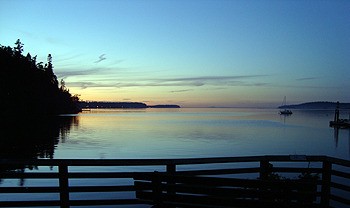Let’s start at the bottom: Sequim Bay is the body of water that graciously takes in almost all water flowing through the fair city of Sequim. Sequim Bay hosts sailors, swimmers, salmon, clams, oysters, a marine lab and much, much more.
And like a genteel hostess keeping all unpleasantness (and disorderly children) out of view, the bay’s glassy surface belies bacteria and nutrient concentrations that regularly contribute to health officials prohibiting the harvest of clams and oysters from its shores.
A step closer is one of my favorite sights: Washington Harbor, the lagoon at the entrance to Sequim Bay.
About 150 years ago its southern shore sheltered a S’Klallam village (Suxtcikwi’In), which isn’t a surprise given the proximity to fresh water and easy fish and shellfish harvesting in the estuary.
Now, vast mudflats exposed at low tide are popular with herons and eagles but the most recent bacteria counts from the harbor exceed standards, making any shellfish growing there unsafe for human consumption year-round.
Upstream from the harbor is Bell Creek, Sequim’s hometown stream. Bell Creek is mostly known as the former irrigation ditch through Sequim that is usually dry but which floods over its banks onto vacant fields and across South Brown Road whenever it rains really hard.
The stream starts high above Happy Valley and flows intermittently (rain-dependent) through the city until the springs east of Carrie Blake Park, where it re-emerges and flows year-round out to Washington Harbor.
Bell Creek is ephemeral in its mid-section, which makes it harder to characterize its condition.
Depending on the reach, researchers have found low oxygen levels, high water temperatures, excessive bacteria or nutrients and copper — which is lethal to certain fish. Unnatural levels of heavy metals including copper, lead and zinc have been found in the sediment in the Bell Creek stream channel and these can affect water quality downstream.
Stream health is commonly indicated by the assemblage of stream bugs found in different reaches, ranging from stoneflies (sensitive to pollution) to worms and leeches (tolerant of pollution). When these critters were studied several years ago, it showed that Bell Creek’s health was highly or critically impaired through the city and also in some sections that flow year-round.
Despite all this, Bell Creek must have favorable a small number of young steelhead and coho salmon are counted each spring migrating out, in addition to sea-run cutthroat. Our little creek is a salmon stream!
Johnson Creek, which empties into the picturesque cove adjacent to John Wayne Marina, is much less studied, but stream bugs sampled near the mouth tell the story that its health is compromised as well.
What to do? It’s tempting to ignore these “disorderly children” — the indicators that the world beneath the shine of our bays and streams is not as lovely as it appears on the surface. But the bugs tell the story … as do vital signs like temperature and oxygen levels.
So we stop driving cars? Outlaw pooping pets? Open a health clinic for salmon? Or, we could find a happy medium where our preventable pollution is prevented.
Neither seen nor heard, water pollution is the cause of ill health for some of our most-loved treasures — and is usually preventable.
Geek Moment
Current snow depth in the upper Dungeness basin on March 17 = 30 inches
Snow-water-equivalent = 8.6 inches (above average)
(Dungeness SNOTEL site, elev. 4,010 ft.)
Cumulative rainfall in Sequim for the water year (starting Oct. 1) = 16.7 inches (far above average)
(Sequim Water Reclamation Facility, elev. 45 ft.)
Addendum
For more geek moments or to learn about preventing pollution, Bell Creek’s fascinating human and natural history, or the city’s Storm & Surface Water Master Plan (public hearing with the city council on April 11), stop by the Interpretive Center at 500 N. Blake Ave. at the city’s Water Reuse Park during staffed hours, noon-2 p.m. Thursdays.
You also can find these topics on the city’s website: www.sequimwa.gov.
Ann Soule is a licensed hydrogeologist working on water quality and quantity concerns in the Dungeness watershed since 1990. She now works for the City of Sequim. Reach her at columnists@sequimgazette.com.



